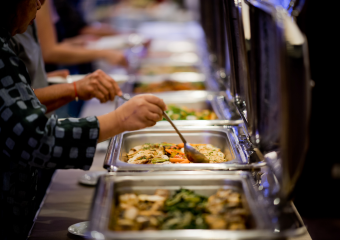Under pressure from cities, DoorDash steps up efforts to ensure its drivers don’t break traffic laws – Winston-Salem Journal
DoorDash said that it’s stepping up efforts to identify dangerous delivery drivers and remove them from its platform after a flood of complaints from cities.
In a letter sent last month to DoorDash and other food delivery companies, Boston officials said they were seeing an increase in the unlawful and dangerous operation of motorcycles, mopeds and motorized scooters by delivery workers.
The city said riders were running red lights, traveling the wrong way on one-way streets, exceeding posted speed limits and driving on sidewalks.
San Francisco-based DoorDash said Tuesday that it has created a dedicated point of contact for the Boston Police Department to make it faster and easier to process requests for drivers’ records. The company said it would also consider removing drivers from the platform if police report they have broken traffic laws.
People are also reading…
DoorDash said it was starting the effort in Boston but may expand it to other cities.
DoorDash said it’s also partnering with Boston and other cities to share guidance on vehicle registration requirements in multiple languages. It will also warn delivery workers about activities that break local laws, like driving on sidewalks.


A food delivery worker rides down a sidewalk after a pickup from a restaurant Jan. 29 in New York.
“We will remind Dashers that failing to comply with local laws or our standards could lead to removal from our platform,” the company said.
Officials in Boston, New York and other cities have said that in many cases, drivers are using unregistered vehicles for deliveries. Some drivers may also share accounts, so a person with multiple traffic violations might be using a vehicle registered to someone else.
In New York, authorities have seized 13,000 scooters and mopeds so far this year that were unregistered or used to break traffic laws.
“They have terrorized many of our pedestrians, particularly our senior and older adults,” New York City Mayor Eric Adams said last month at an event where 200 motorized two-wheeled delivery vehicles were destroyed. “Riders who think the rules don’t apply to them, they’re going to see an aggressive enforcement policy that’s in place.”
In response, DoorDash said it will more frequently prompt drivers to submit a real-time selfie to prove their identity while they’re making deliveries. The selfie is then compared to previously submitted government identification.
DoorDash said it would remove drivers who fail to confirm their identities.
DoorDash wouldn’t say how many drivers it typically removes from its platform each year for breaking traffic laws.
History of food delivery and how it’s changed
History of food delivery and how its changed
To order takeout from your favorite restaurant from an app on your phone may seem like a distinctly modern phenomenon. But food delivery has a history that extends far further back than the smartphone era. A pair of Italian royals in the 19th century are widely considered to be the first pizza delivery customers. And in the 130 years since that fateful time, the history of food delivery has largely mirrored broader historical trends. Wars, technological advances, and shifting forms of labor and work have all played a role in determining how and when people order food to be delivered.
What’s on the horizon for food delivery? Only time will tell, but one clue may be found in the increasing number of people who are interested in nutrition, and how the food that they eat influences the way they feel. Thistle compiled a list of 10 major milestones in the history of food delivery using primary and secondary historical sources. Click through for a look at how food delivery has evolved over the past 130 years.

1889: The first pizza is delivered
In 1889, the first pizza delivery took place in—where else? Italy. King Umberto and Queen Margherita received the delivery. The pie in question came from the famous Pizzeria di Pietro e Basta Così. The Naples-based shop had created a new style of pizza, and wanted to make sure the royals got a chance to try it. So, when the king and queen came to the city, head chef Raffaele Esposito delivered it to them personally. Well over a century later, pizza is a mainstay of the delivery food ecosphere, from royals to commoners alike.
1890s: Dabbawalas deliver lunch to workers in India
In the 1890s, a food delivery system called dabbawala, or “one who carries the box,” sprang up in colonial India. Instead of going home for lunch, or leaving their job sites for food, the dabbawalas bring home-cooked lunches to workers directly in boxes collected from them. Dabbawala originated in Mumbai, and has since spread to other cities. And while the essential concept remains the same, dabbawala has evolved with the times to remain relevant today. Workers today can request lunches and put in orders through text or an app.
1922: Chinese food delivery arrives in America
Chinese food delivery made its debut in America in 1922. The Los Angeles cafe Kin-Chu called itself the “only place on the West Coast making and delivering real Chinese food.” The restaurant made use of the relatively new technology of telephones to fulfill orders. Customers could call to place an order, and the restaurant would deliver as late as 1 a.m. Almost a century later, Chinese food is a popular option for delivery, particularly during the holidays, when other restaurants may opt to close.
1950s: Restaurant food delivery takes off
The popularization of television in the 1950s played a large role in the postwar boom of restaurant food delivery. With televisions in more and more homes, the concept of eating dinner from restaurants at home was established. Families could come home after long days at work and have their meals delivered to enjoy while watching their favorite television programs. This was particularly helpful for many families as the suburbs grew in popularity, and car ownership surged. People no longer necessarily lived nearby their favorite restaurants, and cars made delivery more convenient. Eager to capitalize on the trend, many restaurants even developed “television dinner” menus.
1954: Meals on Wheels launches
A new kind of food delivery was born when Meals on Wheels launched in 1954. The charity developed in Great Britain in response to the economic decline following World War II. Meals on Wheels delivered prepared food to homebound people who might not otherwise have access to food. The organization soon spread to other countries, including the United States. Meals on Wheels is still active today, delivering food to the homebound in cities around the world.
1960s: Delivery speed improves
Thanks in part to the newfound ubiquity of cars, delivery times dropped in the 1960s. On the forefront of this innovation were the founders of Domino’s pizza. They developed a guarantee that pizza would be with clients within 30 minutes or less. The company would later be sued over this guarantee. Lawsuits claimed that 30 minutes was such a short delivery window that the company was encouraging unsafe driving.
1995: World Wide Waiter goes online
In 1995, the first online restaurant delivery service launched. Called World Wide Waiter, the service aggregated more than 60 restaurants in the San Francisco Bay Area, and offered home or office delivery. One of the founders had surprising motivation for starting the company: While convenience and time-saving were nice, he said ordering food to his specs is what gave him the idea for World Wide Waiter. “I liked to order sandwiches made in a particular way,” he told a local newspaper at the time. “It occurred to me that specific orders by computers would be best.”
2000s: Food delivery goes mainstream
In the 2000s, food delivery exploded in popularity. As smartphones became even more popular, food delivery apps came to dominate delivery services. Office workers could order food from their phones to the office without having to step away from their desks, and people who decided they’d rather not cook after work could have dinner solved with a few taps on their phones. New food delivery apps have been continually introduced since the early 2000s. Some specialize in upscale takeout from high-end restaurants, which helped some restaurants stay afloat during the pandemic.
2010s: Meal kit delivery revolutionizes eating-in
In the 2010s, meal kits and ready-made meals made their way into many home kitchens. Some specialized in delivering all the ingredients for a meal to customers who might want to try their hand at cooking something new in the kitchen, but were intimidated by grocery shopping. Still others help consumers stick to speciality diets. This can give aspiring chefs inspiration for cooking future meals on their own, and can help people get used to a new diet without any of the legwork or stress that can go into learning a new way of cooking.
This story originally appeared on Thistle and was produced and distributed in partnership with Stacker Studio.
#lee-rev-content { margin:0 -5px; }
#lee-rev-content h3 {
font-family: inherit!important;
font-weight: 700!important;
border-left: 8px solid var(–lee-blox-link-color);
text-indent: 7px;
font-size: 24px!important;
line-height: 24px;
}
#lee-rev-content .rc-provider {
font-family: inherit!important;
}
#lee-rev-content h4 {
line-height: 24px!important;
font-family: “serif-ds”,Times,”Times New Roman”,serif!important;
margin-top: 10px!important;
}
@media (max-width: 991px) {
#lee-rev-content h3 {
font-size: 18px!important;
line-height: 18px;
}
}
#pu-email-form-breaking-email-article {
clear: both;
background-color: #fff;
color: #222;
background-position: bottom;
background-repeat: no-repeat;
padding: 15px 0 20px;
margin-bottom: 40px;
border-top: 4px solid rgba(0,0,0,.8);
border-bottom: 1px solid rgba(0,0,0,.2);
display: none;
}
#pu-email-form-breaking-email-article,
#pu-email-form-breaking-email-article p {
font-family: -apple-system, BlinkMacSystemFont, “Segoe UI”, Helvetica, Arial, sans-serif, “Apple Color Emoji”, “Segoe UI Emoji”, “Segoe UI Symbol”;
}
#pu-email-form-breaking-email-article h2 {
font-size: 24px;
margin: 15px 0 5px 0;
font-family: “serif-ds”, Times, “Times New Roman”, serif;
}
#pu-email-form-breaking-email-article .lead {
margin-bottom: 5px;
}
#pu-email-form-breaking-email-article .email-desc {
font-size: 16px;
line-height: 20px;
margin-bottom: 5px;
opacity: 0.7;
}
#pu-email-form-breaking-email-article form {
padding: 10px 30px 5px 30px;
}
#pu-email-form-breaking-email-article .disclaimer {
opacity: 0.5;
margin-bottom: 0;
line-height: 100%;
}
#pu-email-form-breaking-email-article .disclaimer a {
color: #222;
text-decoration: underline;
}
#pu-email-form-breaking-email-article .email-hammer {
border-bottom: 3px solid #222;
opacity: .5;
display: inline-block;
padding: 0 10px 5px 10px;
margin-bottom: -5px;
font-size: 16px;
}
@media (max-width: 991px) {
#pu-email-form-breaking-email-article form {
padding: 10px 0 5px 0;
}
}
.grecaptcha-badge { visibility: hidden; }







